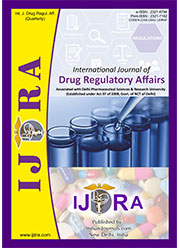SYNTHESIS AND CHARACTERIZATION OF A NOVEL BONE GRAFT MATERIAL CONTAINING BIPHASIC CALCIUM PHOSPHATE AND CHITOSAN FORTIFIED WITH ALOE VERA
Abstract
The bone grafts were prepared using nanohydroxyapatite (nanoHAP) with the extracts of AV and mixed with beta tricalcium phosphate (βTCP) in a ratio of 60:40. The formed BCP was then conjugated with CH to form the bone graft. The Phytochemicals of AV imparts an anti-inflammatory and wound healing property to the bonegraft in addition to its osteoconductivity.
The bone graft was subjected to various conventional characterization techniques like FTIR, XRD, SEM, UV spectrophotometric analysis, compression and tensile strength to reveal its chemical composition, surface morphology and mechanical strength. The UV spectrophotometric analysis and SEM images revealed the mineral deposition on the bone graft after immersing in SBF, thereby increasing its ossification property. FTIR and XRD revealed the presence of BCP with nano HAP crystals and Chitosan in the graft. Compression and tensile strength of the graft showed that the graft can be used in non–load bearing areas.
In this study, a bone graft was synthesized using a novel technique of introducing the extracts of AV in the graft along with BCP and CH. The results revealed that the bone graft can be used as an Osteoconductive material for various biomedical applications.
Downloads
References
2. Suchanek W, Yoshimura M. Processing and properties of hydroxyapatite - based biomaterials for use as hard tissue replacement implants. J Mater Res. 1998;13(1): 94–117.
3. Fu-Yin H, Shiao-Wen T, Chen-Wen L, Yng-Jiin WJ. An in vivo study of a bone grafting material consisting of hydroxyapatite and reconstituted collagen. Mater Sci Mater Med. 2005;16 (4): 341-45.
4. Ding Y, Liu J, Wang H, Shen G, Yu R. A piezoelectric immunosensor for the detection of α-fetoprotein using an interface of gold/ hydroxyapatite hybrid nanomaterial. Biomater. 2007; 28 (12): 2147–54.
5. Albrektsson T, Johansson C. Osteoinduction, osteoconduction and osseointegration. Eur Spine J. 2001;10:S96-S101.
6. Shin SY, Park HN, Kim KH, Lee MH, Choi YS, Park YJ, et al. Biological evaluation of chitosan nanofiber membrane for guided bone regeneration. J Periodont. 2005;76(10): 1778-84.
7. Qi L,Xu Z, Jiang X, Hu C, Zou X. Preparation and antibacterial activity of chitosan nanoparticles. Carbohydr Res. 2004; 339(16): 2693-700.
8. Reynolds T, Dweck AC. “Aloe vera leaf gel: a review update”, J Ethnopharmacol. 1999; 68(1): 3–37.
9. Shin KH, Woo WS, Lim SS, Shim CS, Chung HS, Kennelly EJ, et al. Elgonica-Dimers A and B, Two Potent Alcohol Metabolism Inhibitory Constituents of Aloe arborescens. J Nat Prod. 1997; 60(11): 1180–82.
10. Umano K, Nakahara K, Shoji A, Shibamoto T. Aroma Chemicals isolated and identified from Leaves of Aloe arborescens Mill. Var. natalensis Berger. J Agric Food Chem. 1999; 47(9): 3702- 5.
11. Tang R, Hass M, Wu W, Gulde S, Nancollas GH. Constant composition dissolution of mixed phases. II: Selective dissolution of calcium phosphates. J Coll Interf Sci. 2003; 260(2): 379–84.
12. Kwon SH, Jun YK, Hong SH, Kim HE. Synthesis and dissolution behavior of β-TCP and HA/β-ΒTCP composite powders. J Eur Ceram Soc. 2003; 23(7): 1039 –45.
13. Krithiga G, Antaryamijena P Selvamani Sastry TP. In vitro study on biomineralization of biphasic calcium phosphate biocomposite crosslinked with hydrolysable tannins of Terminalia. Bull Mater Sci. 2011; 34(3): 589 –94.
14. Tas Cu K, neyt A. Synthesis of biomimetic Ca-hydroxyapatite powders at 37ºC in synthetic body fluids. Biomater. 2000; 21(14): 1429-38.
15. Mateus AY, Barrias CC, Ribeiro C, Ferraz MP, Monteiro FJ. Comparative study of nanohydroxyapatite microspheres for medical applications. J Biomed Mater Res A. 2008; 86(2): 483-93.
16. Sarkar KT. Theory and practice of leather manufacture. Chennai: 1965.
17. Ohtsuki C, Kokubo T, Yamamuro T. Mechanism of HA formation of CaO-SiO2 -P2O5 glasses in simulated body fluid. J Non-Cryst Solids 1992;143:184-93.

This work is licensed under a Creative Commons Attribution-NonCommercial 4.0 International License.
The International Journal of Drug Regulatory affairs require a formal written transfer of copyright from the author(s) for each article published. We therefore ask you to complete and return this form, retaining a copy for your records. Your cooperation is essential and appreciated. Any delay will result in a delay in publication.
I/we have read and agree with the terms and conditions stated Page 2 of this agreement and I/we hereby confirm the transfer of all copyrights in and relating to the above-named manuscript, in all forms and media, now or hereafter known, to the International Journal of Drug Regulatory affairs, effective from the date stated below. I/we acknowledge that the IJDRA is relying on this agreement in publishing the above-named manuscript. However, this agreement will be null and void if the manuscript is not published in the IJDRA.
Download link for COPYRIGHT FORM







